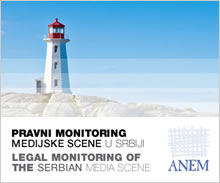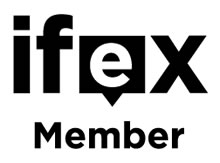16. 01. 2014
CROWED SCREENS
Belgrade, January 16, 2014 (Vreme) - The media reality is currently made up of more than one hundred television stations, complex process of digitization, a largely media illiterate audience, drastically decreased advertising revenues, impoverished and imploded journalist profession.
In place of content that would inform, educate and entertain in an intelligent way, the three new television stations currently offer only clear political interests, recycled TV series , nostalgia and popular TV presenters. When questionable ownership interests and actions is added, then it seems that TV Nova, TV N1 and TV Channel 3 do not offer us anything that we have not seen before.
Logic says that, in times of economic crisis, the number of media outlets decreases. The same logic also says that there is a limited number of media outlets per capita. Since in Serbia logic proverbially does not apply, the local media scene - already jam-packed with approximately 1,200 registered media outlets, with more than one hundred television stations - these days is becoming richer for three new television stations. Channel 3 has been announced as the successor of the former (Radio Television Serbia) Third channel will broadcast in the Belgrade region, the news channel N1 advertises itself as a regional version of CNN , and TV Nova (although still waiting for results of the competition for the allocation of frequencies with national coverage) is making cocktails to mark the beginning of its broadcasting and is bringing "Suleiman" personally, as an illustration of what it will soon offer to the audience.
As the citizens of Serbia are the European record holders in the number of hours spent in front of TV screens, and by the number of television stations probably are at the top of the global charts , the question is why do we need three new TV stations. How will they survive, when the existing media outlets can barely keep their head above water? Does that make any sense, or is there some unknown, internal, logic?
CALCULATIONS: Let's start with the economy. Decline in advertising revenues of the local media outlets, which started in 2009, was stopped last year because of the election: The advertising market was worth 172 million euros then, of which television advertising accounts for 97 million or 56 percent. According to the estimates of Nielsen Media Research, in 2013 this market was reduced by twenty million, and from a total of 150-160 million, the television accounted for 85-90 million. The already reduced marketing income will now have to be divided to more hungry mouths, while the answer to the question of what motivates owners to enter into such a risky business remains theoretical: no owner, no matter how rich and eager for media influence, certainly will not invest millions in something that will, in the long run, only bring him significant losses.
Here, however, we come to the particulars of each television station that we will watch in the future. Channel N1 is the regional CNN partner and the program will be broadcasted from Belgrade, Zagreb and Sarajevo, as well as from "local centers in the cities of the region, and the program will be available to more than 15 million people in three countries." Officially , the owner of this channel is the United Group - a media group operating major cable operators in South Eastern Europe (including SBB and the satellite platform Total TV ), where the position of senior advisor is held by Cameron Munter, former US ambassador to Serbia. N1, therefore , is not CNN, but its political agenda is certainly in line with that American corporation. When one takes into account that the regional branch of Al -Jazeera has daily gains in credibility when competing with (local) news channels, it is logical that someone close to the White House figured out it was time to enter the market of the former Yugoslavia - regardless of possible financial losses.
Even more controversial are the reasons for starting TV Nova. Although they were not successful in the August competition for the allocation of frequencies with national coverage, the leaders of this media came back, and in a big way: not only have they applied again, but are treating the competition as a "done deal", which by all accounts already is ( see box ). But what is their idea? Much bigger players than them long ago have failed or are quickly failing, and the cable television had a detrimental impact on the concept of "national coverage". Nonetheless, Darko Brocic, Executive Director of AGB Nielsen Media Research , gives this television station little better chance for success - in an interview for "Vreme", he points out that 40 percent of Serbia still does not receive cable or satellite television , or IPTV, and that it is a big market for national television stations. On the other hand, it seems that there is a technical problem about which we can only speculate. An informed "Vreme" source , who wanted to remain unnamed, said that TV Nova got leftovers of the TV Avala transmitter network, made up largely of inferior emitter locations. It is "a weaker frequency, mixed network, which can cover up to 40 percent of the territory." The rest is, as he points out, already taken - partly by existing broadcasters, partly reserved for digitization. The owners are almost certainly informed about this, but are thinking ahead: whatever frequency they receive, they are automatically included in the digital multiplex, i.e. the digital broadcasting system which still has room for new channels, but the entry by new broadcasters will be much more complex than for those who get there automatically. In translation , TV Nova is by the present entry into the market making space for itself in the digital future.
As for television Channel 3, it is hard to even speculate on the reasons for its launch. The Belgrade region was in the past considered to be a "black hole" in which, due to the developed cable networks, all those who intended to become the new city television failed.
"Both (TV) Nova and Channel 3 are actually waiting to be bought by a high roller from outside. They are investing, planning for initial losses, but also for long-term profits. It's like a gold digger who is expecting to marry a football player, but previously has to take into debt four generations, to get silicone tits," says one source for "Vreme". The idea about the sale is reasonably for Darko Brocic: "We are not a small market. Large interested media players were already here, I mean RTL and Antenna Plus. We are a larger market than any other in the region, even when marketing is concerned. "
FILLING THE BUDGET: Unlike the owner, whose motivation is still debatable, the interest of the state that is giving out frequencies is clear as day. "Through its satellite, the Republic Broadcast Agency (RBA), the state is implementing the principle that the media exist to fill the budget. The more media outlets get a license to broadcast, the more money will be paid each year. Any further interest in the improvement and development of the media sector stops there. And if the state also overvalues the license, the budget receives more money to cover the manic state spending that has been present for more than two decades and in permanent conflict with the public and development interest," says for "Vreme" independent media consultant Goran Cetinic.
"Relatively few people know that the RBA charges unnecessary high prices the media, who are almost all on the edge of existence. Every year, instead of reducing taxation of media, it is planning how much of surplus it will pay into the state budget, which is hypocrisy contrary to the fundamental principle that a taxpayer should not be taxed more than he can pay. A states which sees only its short-term interests , cannot understand this. Because, as is well known, the Serbian state in reality is made up only of parties and the ruling coalition, so with each elections, or an average of once every few years, a new state is formed hungry for budgetary funds".
Media experts have been warning about the problem of too many broadcast licenses for years, especially since the Council of Europe recommends that each state has a public service broadcaster and two more commercial television stations. When at a public hearing he asked why they do not comply with this recommendation, Darko Brocic was told by representatives of the RBA that under current conditions they would not want to judge, but will let the market be the judge. In the years that followed, it turned out that on the market, in spite of everything, the majority survived - one of the main reasons is probably the fact that in this area, television is watched a lot, as entertainment that costs far less than cinema, theater or books, and does not demands excessive mental engagement .
Local television stations are mostly formatted accordingly - without excessive ambition to educate and properly inform viewers . "All national channels are fairly uniform and offer similar things. Notable is the lack of serious programming, channels with predominant content of culture, education, economics, information technology, new media, programs that emphasized a more positive values, and put in place a new system of values the society", says for "Vreme" ANEM President Milorad Tadic. "I think a mistake was made at the very beginning, when too many licenses were granted without taking into account the diversity of the program to cover the widest range of what is important to the citizens, not just the owners of (TV) stations in the eternal quest for money. Also, there has been a serious failure in control and monitoring of what the media have committed (to broadcast) in their programming plans. That is not honored, it went on without sanctions or by stating shy warnings to broadcasters "
This problem is also pointed out by Goran Cetinic, stating that with granting of licenses in normal states regulations are prescribed on programming, technical, human, financial and other criteria that permit applicant must meet . "If one gets a permit, the regulatory body controls if the permit holder broadcasts the kind of program the license was given for. In Serbia, the form is similar, but the practice is congregation - ruled (sabornost), and the media are failing economically and professionally, morally dependent as beggars from those who give them means of survival."
SEVEN TV DAYS: Despite the enormous number of television stations, from the programming point of view there is still room for new ones, except that these new ones should not be similar to existing ones. In this regard, it will be interesting to see what will the newly arrived players offer to already tormented audiences .
For now, TV N1 relentlessly advertises Jugoslav Cosic as one of its big expectations, TV Nova parades telenovelas and is buying popular TV hosts, while Channel 3 is playing on nostalgia and the alleged urban audience need for a urban television station. At this point, all that - let's be honest - looks like something we have seen before. "There is no more need for channels like the present ones because of the bad taste that gained momentum, that it is becoming unbearable. There is a need for new content, but it all depends on what kind of values we want to emphasize as a society, in which direction we intend to reform ourselves, with what criteria, what should be policy be, regardless of who is in power," said Milorad Tadic . He mentions the example of the ARTE channel, which France and Germany have established a channel for establishing communication and the convergence of the two countries that have fought for centuries.
"Although, it is a channel that is being financed from funds, but this is true with all media outlets that should offer some noncommercial content. Such a thing could be done in Serbia, but to include the former Yugoslav space. All our cultures are very close, we understand each other and such a channel would have great significance in pacifying negative emotions. Of course, it is unlikely such a channel would be profitable. A good model is Euro News, whose program includes a lot of politics, culture, science, and which presents news without the national and political bias."
At this point, however, all sounds like a wish list. The reality is much sadder and includes more than a hundred television stations, a complex process of digitization, a largely media illiterate audience, drastically reduced advertising revenue, impoverished and imploded journalist profession. Instead of content that would inform, educate and provide intelligent entertainment for viewers, new television stations for now offer only clear political interests, recycled series, nostalgia and well known TV personalities.
But we'll see. In the land of miracles , miracles are always possible .
DONE DEAL
When it was announced on 9 August 2013, that TV Nova or TV Kopernicus were not granted frequencies with national coverage, a significant part of the professional community has supported the decision of the RBA Council. It was up to the Ministry of Foreign and Domestic Trade and Telecommunications at that time to concede the network of closed TV Avala for the digitization process - that would be in accordance with the requirements of Brussels, and the Media Strategy and the obligations undertaken by Serbia after the EU donated equipment worth ten million euro for digitization. However, the whole matter was accompanied by rumors of attempted corruption by one candidate, and a theory of the allocation of frequencies was abandoned not because of strategic media planning, but because of the embarrassment that would follow if the frequency granted to that particular candidate .
Avas, the satisfaction of the professional community was short lived. At the repeated competition the RBA had an obligation to open, same candidates applied, and this time TV Nova began to publicly and loudly to announce the commencement of work. Reacting, ANEM in November 2013 publicly asked the RBA Council if such announcements "imply that TV Nova has already won the competition for the national ( terrestrial ) coverage." Meanwhile, TV Nova was even louder - with billboards , Turkish actors and inevitable Serbian VIP characters at a reception marking the launch of the TV station.
A knowledgeable "Vreme" source claims that it really was a done deal. Lobbying began during the first competition, continued during the period from August 2013 to January 2014 and proved to be very effective. Allegedly, a minister in the Serbian government had one of the main roles, and he - probably not for the sake of esteemed audience - was doing his utmost to explain how the allocation of another national frequency will not affect the process of digitization.
Finally, he convinced the one in this country who is asked about everything and is deciding everything. The epilogue will be see soon on our screens.
Author: Tamara Skroza
-
No comments on this topic.





